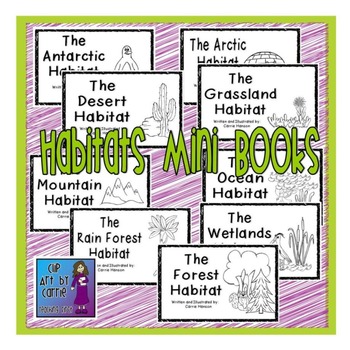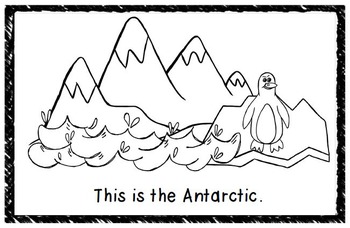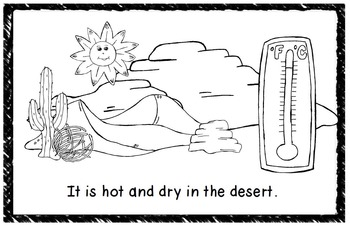Habitats Mini Books: Set of 9 Easy Readers
Clip Art by Carrie Teaching First
3.9k Followers
Grade Levels
K - 2nd, Homeschool
Subjects
Resource Type
Formats Included
- Zip
Pages
108 pages
Clip Art by Carrie Teaching First
3.9k Followers
What educators are saying
I love having this resource to help my students learn. It is a great resource to have for them to do independently.
Loved using these books with our habitat study! My students loved them and were engaged as we read them together. They loved getting to take the readers home!
Description
This zip file contains a set of 9 emergent readers on the following habitats:
ocean
forest
mountain
desert
wetlands
arctic
antarctic
rain forest
grassland
Each book is about 12 pages long and includes a few dominant characteristics of each habitat as well as a few animals that live in each habitat. These are perfect for first grade and have very simple text, picture clues, and picture labels to help with the words.
Here is the text for each booklet: (These books have all been updated April/May 2015, so if you have purchased these books in the past, make sure you download them again to get the update!)
The Antarctic Habitat: updated May 2015
This is the Antarctic habitat.
It is by the South Pole on Antarctica.
They call the Antarctic habitat a cold desert because it gets little water.
Only some plants like grass grow by the ocean coast where there is water.
It is too cold to live there.
It is the windiest place on Earth.
Scientist only go there to study the weather.
But penguins live there all year.
Penguins huddle to stay warm.
The leopard seal hunts for penguins.
Orca whales hunt for penguin and seal.
The Arctic Habitat: updated May 2015
This is the Arctic habitat.
It is at the north pole near the Arctic Ocean.
The Arctic is very cold.
It is very windy in the Arctic.
The ground is covered in ice and snow. This is called the tundra.
Winters are long and summers are short.
Plants grow close to the ground to stay alive in the winter.
Reindeer live in the Arctic. They have thick fur to keep warm in winter.
The Arctic Fox has white fur to blend into the snow.
Polar bear's this fur keeps it warm on land, and fat keeps it warm in the water.
The walrus lives and swims in the Arctic Ocean. Blubber keeps the walrus warm.
The Desert Habitat: updated April 2015
This is that desert habitat.
There can be sand in the desert.
There can be rocks in the desert.
You can see a cactus in the desert.
It is hot and dry in the desert.
A desert is a place that gets less than 10 inches of rain in one year.
It is hot in the day and cool at night.
Animals come out at night when it is cool.
Snakes and scorpions live in the desert.
An oasis is where there is water in a desert.
The Sahara Desert is the biggest desert in the world.
The Forest Habitat: updated April 2015
This is the forest habitat.
Animals live and hide in the forest.
Birds make nests in the trees.
Squirrels hide nuts in the trees.
There are trees and bushes in the forest.
Trees need sun, water, and soil.
There are many kinds of trees.
Some trees lose their leaves in the fall. This is the temperate forest.
Some trees have needles and no leaves. These trees live in the boreal forest where it is colder.
Some trees live where it is warm and hot. Tropical forests are near the equator.
The Grassland Habitat: updated April 2015
This is the grassland habitat.
It is big and wide with a lot of grass.
It does not have enough rain to grow a lot of trees.
It gets enough rain so it is not a desert.
In North America the grassland is called a prairie.
In South America the grassland is called the pampas.
In Asia the grasslands are called the steppes.
In Africa the grassland is called the savannah.
Elephants and giraffes live in the savannah.
Animals travel to find water.
The tall grass helps animals hide.
Cheetahs run fast in the grassland.
The Mountain Habitat: updated April 2015
This is the mountain habitat.
The mountains are rocky and steep.
Mountains can be covered in trees.
But there can be only snow and ice at the top. .
It can be cold and windy at the top. The air is thin and cold
Cougars live in the mountains. They are also called mountain lions or pumas.
Mountain goats climb on the rocky cliffs. They are hunted by cougar, wolves, and bear.
The Rocky Mountains are in North America.
The Andes Mountains are in South America. It is the longest mountain range above ground.
The Himalayan Mountains are in Asia. Mt. Everest is the tallest mountain.
Some mountains are in the ocean. The islands of Hawaii are made from volcanos.
The longest mountain range in the Atlantic Ocean is called the Mid-Atlantic Ridge.
The Ocean Habitat: updated April 2015
This is the ocean habitat.
The ocean is the biggest habitat on earth.
About 70% of the earth is covered in water.
There are five oceans in the world.
You can not drink salty ocean water. But it does help you float.
The ocean can be cold, like the Arctic Ocean.
The ocean can be warm, like the Indian Ocean.
More kinds of fish live near the equator than the colder oceans.
The waves in the ocean are made by wind.
Plants like sea weed grow in the ocean.
Sharks and fish swim in the ocean.
Octopus hide on the ocean floor.
The Rain Forest Habitat: updated April 2015
This is the rain forest habitat.
It gets a lot of rain all year long.
There are a lot of trees and plants.
The very top layer is the emergent layer. It gets the most sunlight.
The next layer is the canopy. It is the “roof” of the rainforest.
The middle layer is the understory.
The bottom layer is the forest floor.
There are many colorful flowers.
Many animals live in the rain forest.
The biggest rain forest is the Amazon Rain Forest in South America.
It is around the Amazon River.
The Wetlands Habitat: updated April 2015
This is the wetlands habitat.
There are plants and grass at the wetland.
Beavers build their home at the wetland.
Ducks and geese swim in the pond.
An alligator swims in the swamps.
The wetlands have fresh water.
Animals can drink water from the wetland.
Only 1% of earth’s water is fresh water.
Fresh water comes from rain and melted snow.
Streams and rivers are moving water.
Rivers and streams start in the mountains.
Pictures are very similar to my Habitats Cut Apart Sentences and also my Habitat Vocabulary Book. Also check out my new Habitats Interactive Notebook to go right along with this unit!
Written and illustrated by:
Carrie Hanson
Clip Art by Carrie Teaching First
www.ccteachfirst.blogspot.com
ocean
forest
mountain
desert
wetlands
arctic
antarctic
rain forest
grassland
Each book is about 12 pages long and includes a few dominant characteristics of each habitat as well as a few animals that live in each habitat. These are perfect for first grade and have very simple text, picture clues, and picture labels to help with the words.
Here is the text for each booklet: (These books have all been updated April/May 2015, so if you have purchased these books in the past, make sure you download them again to get the update!)
The Antarctic Habitat: updated May 2015
This is the Antarctic habitat.
It is by the South Pole on Antarctica.
They call the Antarctic habitat a cold desert because it gets little water.
Only some plants like grass grow by the ocean coast where there is water.
It is too cold to live there.
It is the windiest place on Earth.
Scientist only go there to study the weather.
But penguins live there all year.
Penguins huddle to stay warm.
The leopard seal hunts for penguins.
Orca whales hunt for penguin and seal.
The Arctic Habitat: updated May 2015
This is the Arctic habitat.
It is at the north pole near the Arctic Ocean.
The Arctic is very cold.
It is very windy in the Arctic.
The ground is covered in ice and snow. This is called the tundra.
Winters are long and summers are short.
Plants grow close to the ground to stay alive in the winter.
Reindeer live in the Arctic. They have thick fur to keep warm in winter.
The Arctic Fox has white fur to blend into the snow.
Polar bear's this fur keeps it warm on land, and fat keeps it warm in the water.
The walrus lives and swims in the Arctic Ocean. Blubber keeps the walrus warm.
The Desert Habitat: updated April 2015
This is that desert habitat.
There can be sand in the desert.
There can be rocks in the desert.
You can see a cactus in the desert.
It is hot and dry in the desert.
A desert is a place that gets less than 10 inches of rain in one year.
It is hot in the day and cool at night.
Animals come out at night when it is cool.
Snakes and scorpions live in the desert.
An oasis is where there is water in a desert.
The Sahara Desert is the biggest desert in the world.
The Forest Habitat: updated April 2015
This is the forest habitat.
Animals live and hide in the forest.
Birds make nests in the trees.
Squirrels hide nuts in the trees.
There are trees and bushes in the forest.
Trees need sun, water, and soil.
There are many kinds of trees.
Some trees lose their leaves in the fall. This is the temperate forest.
Some trees have needles and no leaves. These trees live in the boreal forest where it is colder.
Some trees live where it is warm and hot. Tropical forests are near the equator.
The Grassland Habitat: updated April 2015
This is the grassland habitat.
It is big and wide with a lot of grass.
It does not have enough rain to grow a lot of trees.
It gets enough rain so it is not a desert.
In North America the grassland is called a prairie.
In South America the grassland is called the pampas.
In Asia the grasslands are called the steppes.
In Africa the grassland is called the savannah.
Elephants and giraffes live in the savannah.
Animals travel to find water.
The tall grass helps animals hide.
Cheetahs run fast in the grassland.
The Mountain Habitat: updated April 2015
This is the mountain habitat.
The mountains are rocky and steep.
Mountains can be covered in trees.
But there can be only snow and ice at the top. .
It can be cold and windy at the top. The air is thin and cold
Cougars live in the mountains. They are also called mountain lions or pumas.
Mountain goats climb on the rocky cliffs. They are hunted by cougar, wolves, and bear.
The Rocky Mountains are in North America.
The Andes Mountains are in South America. It is the longest mountain range above ground.
The Himalayan Mountains are in Asia. Mt. Everest is the tallest mountain.
Some mountains are in the ocean. The islands of Hawaii are made from volcanos.
The longest mountain range in the Atlantic Ocean is called the Mid-Atlantic Ridge.
The Ocean Habitat: updated April 2015
This is the ocean habitat.
The ocean is the biggest habitat on earth.
About 70% of the earth is covered in water.
There are five oceans in the world.
You can not drink salty ocean water. But it does help you float.
The ocean can be cold, like the Arctic Ocean.
The ocean can be warm, like the Indian Ocean.
More kinds of fish live near the equator than the colder oceans.
The waves in the ocean are made by wind.
Plants like sea weed grow in the ocean.
Sharks and fish swim in the ocean.
Octopus hide on the ocean floor.
The Rain Forest Habitat: updated April 2015
This is the rain forest habitat.
It gets a lot of rain all year long.
There are a lot of trees and plants.
The very top layer is the emergent layer. It gets the most sunlight.
The next layer is the canopy. It is the “roof” of the rainforest.
The middle layer is the understory.
The bottom layer is the forest floor.
There are many colorful flowers.
Many animals live in the rain forest.
The biggest rain forest is the Amazon Rain Forest in South America.
It is around the Amazon River.
The Wetlands Habitat: updated April 2015
This is the wetlands habitat.
There are plants and grass at the wetland.
Beavers build their home at the wetland.
Ducks and geese swim in the pond.
An alligator swims in the swamps.
The wetlands have fresh water.
Animals can drink water from the wetland.
Only 1% of earth’s water is fresh water.
Fresh water comes from rain and melted snow.
Streams and rivers are moving water.
Rivers and streams start in the mountains.
Pictures are very similar to my Habitats Cut Apart Sentences and also my Habitat Vocabulary Book. Also check out my new Habitats Interactive Notebook to go right along with this unit!
Written and illustrated by:
Carrie Hanson
Clip Art by Carrie Teaching First
www.ccteachfirst.blogspot.com
Total Pages
108 pages
Answer Key
N/A
Teaching Duration
N/A
Report this resource to TPT
Reported resources will be reviewed by our team. Report this resource to let us know if this resource violates TPT’s content guidelines.





